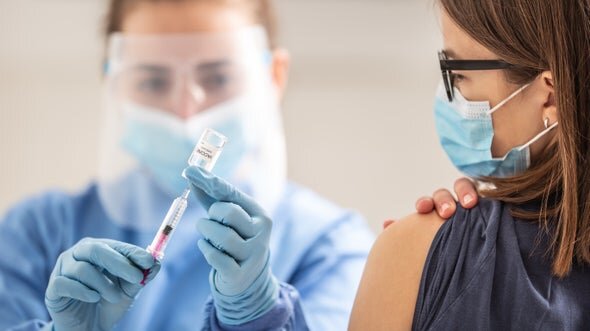Adolescents Can Finally Get Vaccinated against COVID - Scientific American
Pfizer-BioNTech vaccine approval is younger teens’ shot at freedom
By Tara Haelle on May 13, 2021
Pfizer-BioNTech COVID-19 vaccine is now approved for use in adolescents aged 12 to 15. Credit: Marian Vejcik Getty Images
In a long-awaited announcement on Monday, the U.S. Food and Drug Administration authorized the use of the Pfizer-BioNTech COVID-19 mRNA vaccine in adolescents aged 12 to 15. The Centers for Disease Control and Prevention’s Advisory Committee of Immunization Practices (ACIP) at the Centers for Disease Control and Prevention met on Wednesday to discuss using the vaccine in adolescents and formally recommended immunizing this age group.
While COVID-19 is not typically as serious in children as it is in adults, the disease is not necessarily benign in kids either. And having more infections in the population puts everyone at greater risk, says Kawsar Talaat, an epidemiologist at the Johns Hopkins Bloomberg School of Public Health and a principal investigator of the Pfizer-BioNTech vaccine trials in adults and in children aged six months to 12 years.
“As we’re vaccinating older people, we are driving the virus into younger populations, and anybody the virus infects can potentially have a variant develop in them,” Talaat says. “From a community perspective, to stop the virus’s transmission and the formation of new variants, we have to vaccinate everybody, including kids.” Teenagers, especially, can drive infections because of their social behavior, but it is important to vaccinate all children eventually, she says, “because every person who’s vaccinated is one more barrier to the virus being transmitted.” Talaat also worries about potential long-term effects of COVID-19 in kids and about their mental health. “How our kids regain a normal life is to be vaccinated,” she says.
VACCINATING TEENS AND CHILDREN IS KEY
More than 3.85 million children have tested positive for COVID-19 in the U.S., according to the American Academy of Pediatrics. The novel coronavirus has caused more than 15,700 hospitalizations and more than 300 deaths among kids in the states and territories that have reported the data. Children have also begun making up a larger proportion of COVID-19 cases: they represent 24 percent of cases in the first week of May and 14 percent of all cases since the pandemic began, including a 4 percent increase from April 11 to May 6.
Some experts have begun doubting the likelihood of achieving herd immunity to COVID-19—having enough people who are immune to the disease in the population to ensure that it cannot continue spreading. But if herd immunity is otherwise possible, it is very unlikely we can reach it without vaccinating kids, Talaat says. Experts estimate that 70 to 85 percent of people need to be immune to COVID-19, either through past infection or vaccination, to achieve herd immunity, she adds, and people younger than age 18 make up nearly a quarter of the U.S. population. Not all adults will get vaccinated, and some will remain vulnerable afterward because of immune-suppressing or other underlying conditions, Talaat says. And even discounting herd immunity, vaccines are crucial to curbing the pandemic.
“We’re not going to get a handle on the pandemic if we exclude kids, especially teens,” says Nathan Boonstra, a pediatrician at Blank Children’s Hospital in Des Moines, Iowa. “It’s important to vaccinate everybody we can if the vaccines are available.”
The new FDA authorization is based on data from a phase III placebo-controlled trial involving 2,260 adolescents between the ages of 12 and 15, including 1,131 who received the two-dose Pfizer-BioNTech vaccine. As in adults, the most commonly reported side effects were pain at the injection site, tiredness, headache, fever, chills, and muscle or joint pain—with stronger reactions after the second dose. The vaccine is not recommended for anyone with a known history of severe anaphylaxis after exposure to one of its ingredients.
The trial’s primary goals were assessing the vaccine’s safety and its ability to induce an immune response. But data also showed it prevented 100 percent of symptomatic COVID-19 among the vaccinated participants. Plus, the mRNA vaccines have already shown extraordinary safety in adults, Talaat says.
“Never ever have we had a vaccine [made] available to children that has been put into over 100 million adults already,” she says, referring to the combined total of mRNA vaccines administered in the U.S. “That’s an amazing safety track record.”
HOW MANY TEENS WILL GET THE VACCINE?
Now two big questions remain: How many parents will get their teens vaccinated? And when will vaccines for younger children be available?
The answer to the second question is that shots for young kids will likely be available sometime this fall. Pfizer has begun phase I trials—the first step to approval—in children aged six months to 11 years and hopes to seek FDA authorization for children aged two to 11 years in early September. Trials take longer for younger groups because researchers must test different doses—10, 20 or 30 micrograms of vaccine per shot—to determine which one has the most minimal side effects while remaining effective. Twelve- to 15-year-olds receive the same doses as adults.
“When you get down to younger age groups, you have to do much more extensive dose-ranging studies to make sure you have that clearly in hand before you move to any phase III setting,” says Paul Offit, an infectious disease pediatrician and director of the Vaccine Education Center at Children’s Hospital of Philadelphia. Offit serves on an FDA advisory committee that will meet next month to determine the agency’s expectations for the data necessary to authorize a vaccine in younger populations.
As for how many teens will get the vaccine, the landscape looks similar to that of adults now. According to ongoing surveys by the Kaiser Family Foundation, three in 10 parents (30 percent) plan to vaccinate their 12- to 15-year-olds against COVID-19 as soon as the shot is available. And a quarter (26 percent) will “wait and see” how other adolescents fare before vaccinating their child. Another quarter (23 percent) said they definitely will not do so.
Some teens may want to get vaccinated even if their parents oppose it, so the Web site VaxTeen has compiled each state’s consent laws regarding where adolescents can receive the vaccine without parental permission.
Boonstra is already talking with families about the vaccine and says most are eager to get it. When they ask his opinion, he tells them its safety looks good and then shares his concerns about the coronavirus. “There’s a lot we don’t know yet about the virus and its long-term effect on kids, and I worry about seeing that the virus causes significant amounts of inflammation in places like the heart and lungs,” he says. “There’s no comparison. I’m far more worried about what the disease does to kids than the vaccine.”
Offit is also concerned about COVID-19’s long-term effects and the potential for more variants to occur as transmission continues. “If the virus continues to spread, you just allow for a greater and greater chance of variants to be created—especially the one you’re worried about, which is one that is completely resistant to immunity by natural infection or immunization,” he says. Offit also points out that even though COVID-19 deaths are much lower in children than adults, the rates are similar to annual chicken pox and measles deaths before widespread vaccination for those diseases. The same is true for influenza, Talaat says. “We lose 100 to 180 kids a year to flu, and we vaccinate against flu every year because one kid dying is one kid too many,” she says.
VACCINES MEAN A RETURN TO NORMALCY
Perhaps the most compelling reason for parents to vaccinate their children, however, is to restore a sense of normalcy to their life, says Karen Ernst, executive director of the national parent advocacy group Voices for Vaccines.
“It’s really important for kids to be vaccinated because we want them to go back to having normal childhoods—to be in school, to be able to ditch their masks and hang out with their friends,” Ernst says. She is preparing for the inevitable wave of misinformation that will come with the push to vaccinate children. But she thinks the best way to ensure good uptake is to make vaccines as accessible as possible, including by meeting parents where they are—geographically and mentally—and answering their questions without judgment.
“People need others to explain to them exactly why the vaccine is safe for adolescents and why it’s important for kids to get the vaccine,” Ernst says. Although kids cannot get back the year they have already lost, the vaccine can stop them from losing another one, she adds. “That needs to be part of the risk-benefit analysis that parents do about the vaccine: it’s also about letting our kids go back to childhood now,” Ernst says.
Returning to normal means a return to in-person school, too, which is essential for many children’s education and for their mental and physical health. “If we are intent on getting kids in the classroom—as I think we should be—we need to make sure it’s as safe as possible,” Boonstra says. “The number-one thing to do that is to make sure as many kids are vaccinated as possible.”


